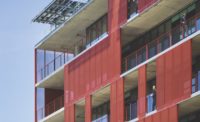Four decades after his death, Louis Kahn remains one of the world’s most influential 20th-century architects. And nowhere is he more renowned than in Philadelphia—a somewhat ironic reality, since most of the iconic projects for which he is best known, such as the Salk Institute, the Kimbell Art Museum, and the Library at Philips Exeter Academy, are located elsewhere. But Philadelphia was Kahn’s home for most of his life, from the age of five, when he emigrated from Estonia. He studied architecture there, practiced there, and taught there. It is fitting then, that a major traveling retrospective of his work, Louis Kahn: The Power of Architecture, is finally being shown in Philadelphia, five years after it first opened at Netherlands Architecture Institute (NAI), in Rotterdam.
The exhibition, at the Fabric Workshop and Museum in Center City, was organized by the Vitra Design Museum in Weil am Rhein, Germany, in collaboration with NAI and the Architectural Archives of the University of Pennsylvania, the steward of Kahn’s archives. Since its first showing in 2012, The Power of Architecture has toured the world, with venues in eight other cities, including London, Taipei, Oslo, and Fort Worth, where it was shown at the Kimbell. Philadelphia is the show’s last stop—and the only one on the East Coast.
The Power of Architecture comprises about 300 objects, including drawings, photos, and even personal effects, like the leather valise that he brought when he traveled to his far-flung project sites, or the box of pastels he used to make his evocative sketches. And of course there are models, many of them study models, fascinatingly stained and worn, showing the evidence of how a particular scheme changed and developed throughout the course of the design process. Some of this material was shown in the early 1990s traveling retrospective put together by the Museum of Contemporary Art, Los Angeles. But unlike that show, which presented works chronologically, the current exhibition is organized around themes such as city, science, landscape, and community. This structure reveals connections among his projects as well as their relationships to nature and to the classical architecture he sketched on his travels.
But the show, which runs through November 5th, is not limited to already-exhibited pieces merely reassembled. There is new material here as well, such as film clips shot by Kahn’s son, Nathaniel, director of My Architect. These focus on the Kimbell, the National Assembly in Dhaka, Bangladesh, and the Fisher House in suburban Philadelphia. The latter is shown near a full-scale mockup of the house’s window seat made specifically for the exhibition. The Power of Architecture also includes taped interviews with architects such as Frank Gehry, Renzo Piano, Peter Zumthor, Sou Fujimoto, and Alejandro Aravena, who talk about the influence of Kahn’s work.
There are a few items unique to the Fabric Workshop rendition of the show, including Kahn’s study for a mural for the Weiss House, in nearby Montgomery County. The charcoal drawing depicts abstracted trees, mountains, fields, and pitched roofs. William Whitaker, curator of the University of Pennsylvania’s Architectural Archives, says that the piece is particularly appropriate for this stop of the exhibition since its subject is the Southeastern Pennsylvania landscape.
Whitaker is careful to point out that he is not the curator of The Power of Architecture, though it naturally relies heavily on materials from the Archives’ collection. But he has taken advantage of the opportunity presented by its showing in Philadelphia to organize a companion exhibit on the University of Pennsylvania campus opening on August 29th. The small show will explore the music barge that Kahn designed for conductor Robert Austin Boudreau and his American Wind Symphony Orchestra, and will include sketches, models, film footage, and historic photographs of the concert boat, called Point Counterpoint II. The vessel toured small cities and towns across America for four decades. Now, Boudreau, who is 90, has decided to retire from operating the barge, and hopes to sell it. If he’s not successful, Point Counterpoint II could end up in the scrap yard. The exhibit, Louis Kahn, Barge Architect, which Whitaker calls “rather impromptu,” is intended to support the effort to save the boat. It runs through November 13.
Louis Kahn: The Power of Architecture
Through November 5
The Fabric Workshop and Museum
1214 Arch Street
Philadelphia, PA 19107
Tuesday, August 29 through Monday, November 13, 2017
Harvey and Irwin Kroiz Gallery
The Architectural Archives, University of Pennsylvania
220 South 34th Street
Philadelphia, PA 19104




























Post a comment to this article
Report Abusive Comment